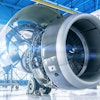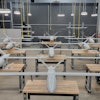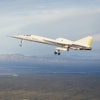What is the most disruptive idea since the Wall Street Crash of 1929? Bloomberg Businessweek, which turned 85 this fall, picked one idea for every year it’s been publishing, and the jet engine soared to the top of the list, above “The Pill,” Google search, television, e-mail and microchips.
The first jet engines were built by Britain’s Frank Whittle and Germany’s Hans von Ohain in the 1930s. Like many important breakthroughs, including radar, GPS and the Internet, the jet engine started out as a military project powering experimental aircraft. The two jets that saw combat during the waning months of World War II were the Royal Air Force’s Gloster Meteor and the Luftwaffe’s Messerschmitt Me 262. (Sir Frank - he was knighted for his effort - and Von Ohain didn’t meet until 1966.)
The jet engine really took off after the war. “By the 1960s this one invention had shrunk the world,” Bloomberg Businessweek wrote. “For the first time the entire surface of the planet was reachable—or at least viewable—and its wonders opened up.”
A top-secret group of GE engineers called the Hush-Hush Boys, working in a small shack near Boston, did some of that shrinking. Starting in 1941, they re-engineered Sir Frank’s jet engine and used it to power America’s first military jet, the P-59 Airacomet. “We could only run it for a short while,” Joseph Sorota, one of the original Hush-Hush Boys, told GE Reports. “We took it apart, put it together again, and ran more tests. We went on with designing.”
All that testing and research eventually led to GE’s J47 engine, which in 1947 became the first jet engine certified for commercial aviation in the U.S. It cost $340,000 in 2014 dollars. The list price of GE’s latest engines like the GEnx tops $20 million.
In the 1960s, GE built the world’s first high-bypass turbofan engine, the grandfather of the GEnx and the vast majority of jet engines powering commercial aircraft around the world.
Today, GE Aviation is a $22 billion business (2013 revenues). Every two seconds, a commercial jet powered by engines made by GE or its joint-venture partners takes off somewhere in the world. There are 34,000 GE commercial engines flying and 25,000 GE military engines in service.
The latest generation of GE jet engines, such as the GE9X, the largest jet engine ever built, have 3D printed parts and components made from new light and heat-resistant materials called ceramic matrix composites (CMCs).
But these are technologies for some future most disruptive idea list.
For more articles like this, check out GE Reports.






















